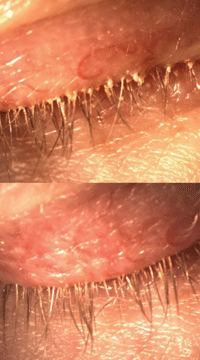We’ve been authoring the “Therapeutic Review” column for 10 years now. In one of our very first entries, “Put a Lid on Blepharitis,” we discussed the importance of differentiating the various forms of blepharitis and creating an individualized treatment strategy for each patient.1
 |
Like many procedures and protocols in eye care, blepharitis management has evolved during the last decade. It’s time to revisit this topic and examine some of the newest, most promising treatment options.
Calling Your Bleph
A recently published survey of eye care providers suggested that some form of blepharitis is present in nearly half of our patients––whether or not they are symptomatic upon presentation.2 This means that every practicing optometrist likely sees this condition in one form or another on a daily basis.
Unfortunately, our traditional therapies for blepharitis have relied heavily on ongoing patient-administered intervention and compliance. Newer treatment modalities not only provide more targeted therapy, but also offer the promise of rapid recovery for most individuals.
Scrub-a-Dub-Dub
Lid scrubs have long been the mainstay of blepharitis management. Detergent-based products, such as OcuSoft Lid Scrub or TheraTears SteriLid, applied to the lids and lashes help to remove accumulated debris and excessive oils from the eyelid margins. Also, these products diminish bacterial reservoirs, combating the overgrowth of flora that incites and perpetuates staphylococcal blepharitis.
• BlephEx. As mentioned previously, the effectiveness of home-based lid scrubs is directly contingent upon the patient’s level of dexterity, thoroughness and overall compliance. Recently, however, RySurg introduced BlephEx
––a handheld device that allows physicians to perform an in-office “deep cleansing” of the lid margins. James Rynerson, MD, principal developer of BlephEx and CEO of Rysurg, LLC, refers to this new treatment as “microblepharoexfoliation.”
BlephEx is indicated for removal of lid debris and microbial biofilm, which Dr. Rynerson touts as the primary source of all ocular surface inflammation. The device incorporates a disposable, high-speed, rotating microsponge designed to clean both the anterior and posterior lid margins, making it appropriate for all forms of blepharitis. In practice, we use BlephEx in cases of staphylococcal and seborrheic blepharitis, demodicosis and even MGD as a form of debridement scaling for the meibomian glands.3
 |
|
|
This 80-year-old woman presented with severe blepharitis secondary to Demodex folliculorum infestation (top). Following microblepharoexfoliation, she exhibited improvement (bottom).
|
Be aware that there is no ICD-9 code associated with BlephEx at this time, and thus no insurance coverage. Patients’ out-of-pocket costs for the procedure typically range from $150 to $200, or more in some cases. Like dental cleanings, this procedure is recommended semi-annually––or even more frequently in severe cases.
Dropping Acid (on the Lids)
While surfactant cleaners certainly have a role in blepharitis management, they can be messy, irritating and unpleasant for some patients. Moreover, if conventional cleansers fail to control bacterial replication adequately, practitioners may need to resort to more aggressive therapies, such as topical antibiotics or antibiotic-steroid combinations.
• i-Lid Cleanser. Recently, NovaBay Pharmaceuticals introduced this novel antiseptic agent specifically indicated for the treatment of blepharitis. The company describes it as “the first FDA 510K-cleared prescription product to clean the lids and lashes, removing the debris and microorganisms that cause chronic inflammation.”
i-Lid Cleanser is a stabilized solution comprised of 0.01% hypochlorous acid (HOCl), a microbicidal component of the innate immune system.4 HOCl is naturally produced by neutrophils in response to pathogenic organisms, and can kill bacteria, block bacterial-derived toxins and blunt the effects of human cell-derived pro-inflammatory mediators.5,6
The product is packaged in a glass bottle with a pump sprayer, and can be applied to the lids via a cotton ball, cosmetic pad or gauze. While there aren’t yet any specific clinical studies demonstrating its efficacy, colleagues employing the product in their blepharitis treatment regimen have noted substantial improvement in both signs and symptoms when applied BID for just 10 days.7 i-Lid Cleanser is sold exclusively through physicians’ offices and online by the manufacturer. It retails for approximately $30 for a 40mL bottle.
Demodex
Demolition
During the time that we’ve been writing the “Therapeutic Review” column, Demodex has gone from being a vague, rarely-recognized and poorly managed lid pathogen to one of the most common causes of blepharitis that we see in clinical practice. We’ve known for some time that it is resistant to most conventional lid cleansers and antimicrobial agents, but is highly responsive to tea tree oil.8
• Cliradex. A recently published study identified the most potent demodicidal element in tea tree oil to be terpinen-4-ol, or 4-terpineol.9 This chemical compound is the active ingredient in Bio-Tissue’s Cliradex lid wipes. The company suggests that it is “a natural, preservative-free lid, lash and facial cleanser that helps manage symptoms associated with blepharitis, meibomian gland dysfunction, rosacea, dry eye, Demodex, chalazia and other lid margin diseases.”
Since its release last September, Cliradex has become a mainstay treatment for our patients with demodicosis and ocular rosacea (which also seems to have a probable association with Demodex).10 Also, it has eliminated the need to obtain pharmaceutically compounded agents of varying concentrations for Demodex infestation.
We typically prescribe Cliradex BID for 10 days, and then QD at bedtime for another 10 days in cases of Demodex blepharitis, ideally after performing microblepharoexfoliation. The product is sold exclusively through physicians’ offices and online, and retails for about $40 per carton, which contains 24 lid wipes.
Bio-Tissue also recently introduced the Cliradex Complete kit, which contains one carton of Cliradex lid wipes, a tube of Cliradex Advanced Care gel (a slightly more concentrated version of 4-terpineol for in-office application to the lids and lashes), a dual-sided applicator and instructions for the doctor and patient. This kit is designed for use by eye care clinicians only, and so individual providers typically will determine patient cost as a combination in-office/at-home therapeutic procedure.
Time marches on––but fortunately, each passing year brings a greater understanding of the physical maladies that plague our patients, as well as provides us with new tools to control their deleterious effects. Even something as seemingly common as blepharitis warrants consideration and intervention to help improve our patients’ vision and overall quality of life.
We would also like to express our gratitude to the editors who have worked with us on this column throughout the past 10 years, including Jen Kirby, Leah Addis and especially our current editor, Mike Hoster.
Dr. Kabat is a paid consultant to Bio-Tissue and Alcon Laboratories. Neither he nor Dr. Sowka has any direct financial interest in the products mentioned.
1. Kabat AG, Sowka JS. Put a lid on blepharitis. Rev Optom. 2004 Nov; 141(11):123-4.
2. Lemp MA, Nichols KK. Blepharitis in the United States 2009: A survey-based perspective on prevalence and treatment. Ocul Surf. 2009 Apr;7(2 Suppl):S1-S14.
3. Korb DR, Blackie CA. Debridement-scaling: a new procedure that increases Meibomian gland function and reduces dry eye symptoms. Cornea. 2013 Dec;32(12):1554-7.
4. Wang L, Bassiri M, Najafi R, et al. Hypochlorous acid as a potential wound care agent: part I. Stabilized hypochlorous acid: a component of the inorganic armamentarium of innate immunity. J Burns Wounds. 2007 Apr 11;6:e5.
5. Gray MJ, Wholey WY, Jakob U. Bacterial responses to reactive chlorine species. Annu Rev Microbiol. 2013;67:141-60.
6. Ono T, Yamashita K, Murayama T, Sato T. Microbicidal effect of weak acid hypochlorous solution on various microorganisms. Biocontrol Sci. 2012;17(3):129-33.
7. Krader CG. Ophthalmology Times. Hypochlorous acid lid cleanser provides novel advantages. Available at: http://ophthalmologytimes.modernmedicine.com/ophthalmologytimes/news/hypochlorous-acid-lid-cleanser-provides-novel-advantages. Accessed September 14, 2014.
8. Gao YY, Di Pascuale MA, Li W, et al. In vitro and in vivo killing of ocular Demodex by tea tree oil. Br J Ophthalmol. 2005 Nov;89(11):1468-73.
9. Tighe S, Gao YY, Tseng SC. Terpinen-4-ol is the most active ingredient of tea tree oil to kill Demodex mites. Transl Vis Sci Technol. 2013 Nov;2(7):2.
10. Holmes AD. Potential role of microorganisms in the pathogenesis of rosacea. J Am Acad Dermatol. 2013 Dec;69(6):1025-32.

